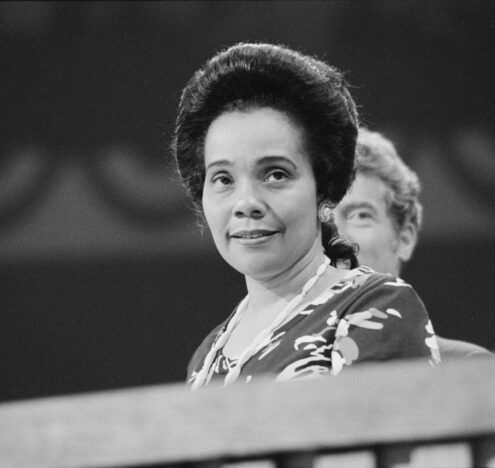The meaning of images of uniformed servicemembers in American popular culture is deeply fraught and unsettled. The gamut runs from the jingoistic to the nostalgic to the critically ironic to everything in between. A short video during the pregame programming of servicemembers deployed to Kuwait getting ready to watch the Super Bowl last month is an occasion to explore the nature of these complicated dynamics. The video was very short, featured servicemembers in uniform, identified their location as Kuwait, and showed them waving enthusiastically. None of them spoke and the network provided no information about their unit or units. The fact of their military service, but nothing about its specifics, is foregrounded for those watching at home in America.
The video knits together Americans at home with those deployed overseas through the shared experience of the game. How this suturing works, and the conditions that allow for it, is worth examining in some detail. The treatment of servicemembers as unspeaking props during the pre-game festivities of Super Bowl LVI is harmful to civil-military relations because it is both a symptom of a sharp divide between those in uniform and those out of it — and perpetuates that divide.
“REVERENT BUT DISENGAGED”
In a time of high institutional distrust, the military measures out at high levels of trust — though it has been dropping since about 2018. The cultural civ-mil divide expands as few Americans relative to the overall population serve in the Armed Forces even during two decades of war. However, rather than decrease trust, the fact that so few Americans have direct experience or even broad familiarity with the military contributes to the high institutional trust.
This is the main thrust of “Warriors and Citizens,” a 2016 collection of essays edited by Kori Schake and Jim Mattis. They wonder about a “Great Divergence” between warriors and citizens. They worry that there is a danger of the military becoming increasingly insular and isolated from those it serves: “The military even could come to consider itself a society apart, different from and more virtuous than, the people they commit themselves to protecting…as one soldier described it.” A uniformed servicemember worries about a world in which their own service severs them from the very public from which they are voluntarily drawn.
In November 2021, the Ronald Reagan Institute issued a National Defense Survey that showed fading levels of trust in the military among Americans. According to the report, the decline is steep and is sharp across many demographics of Americans. The report notes that while the military still enjoys high levels of trust relative to other institutions, the level of trust in the military is falling off more quickly relative to other institutions. James Fallows’s 2015 article in The Atlantic, “The Tragedy of the American Military,” is useful for thinking through the relationship between the popular representation of American servicemembers and civilian-military relations. Fallows takes seriously the role of television in both responding to American attitudes toward people in uniform and helping to shape those attitudes. He charts an oscillation between attention and inattention, between engagement and boredom of Americans when it comes to military matters. He sums it up: “This reverent but disengaged attitude toward the military — we love the troops, but we’d rather not think about them — has become so familiar that we assume it is the American norm.” What’s more, watching TV and then turning away from TV to other devices is central to this oscillation. Americans attend to military matters by being spectators and that spectatorship is mediated through a screen.
Perpetuating an engaged but reverent attitude to the military by turning servicemembers into spectacles and making spectators of citizens is bad for all of us.
Fallows insists that “this reverent but disengaged attitude” is part of this particular historical moment. In a pre-9/11 era, Americans didn’t necessarily relate to the military primarily through screens and primarily in such an inflexibly incoherent way. Instead, on-screen images of the military could be irreverent precisely because more Americans had direct engagement with the military, for example, through the Vietnam draft or fierce disagreements about the Vietnam war. Fallows’s formulation that Americans are “reverent but disengaged” is a useful balancing act — and one that is useful for pointing out the harm it causes to the civilian-military relationship.
That brings us back to the Superbowl. To understand the complicated relationship between the image of troops before the Superbowl and civ-mil relations, it’s helpful to think about the extremely close relationship between the NFL and television. The common line runs that a deeply intertwined, mutually beneficial relationship exists between the NFL and television and the Super Bowl and television. The Super Bowl is tailor-made for television and the American public responds by tuning into the spectacle in huge numbers. Nielsen reports that 101 million people watched Super Bowl LVI, which is approximately one-third of the American public. That’s an absolutely massive number of eyes on the troops in Kuwait, with many Americans who have never seen a servicemember in uniform in real life watching deployed servicemembers in uniform for a short time. These two facts crystallize an ambivalence at the heart of popular engagement with the US military; what Fallows calls that “reverent but disengaged” attitude.
SERVICEMEMBERS ARE NOT SPECTACLES
The very fact that the images of troops in Kuwait were included in the pre-game festivities is a form of reverence. The logic seems to be that the American military is too important to American culture at large to exclude from the NFL’s pageantry. At the same time, the on-screen, silent presence of troops in Kuwait crystallizes American disengagement from the military. Despite being broadcast into homes in the US, the brief snippet highlighted the geographic distance between Americans at home and American servicemembers abroad. Moreover, the fact that only servicemembers in Kuwait were featured is noteworthy. Well-known travel destinations for Americans include Japan, Italy, and Germany, and each has a large US military presence, and were not featured in the short clip. Places that may be familiar to Americans from their own travels or from the travels of friends and family were shoved aside in favor of a place that, because of its proximity to Iraq (or depending on how many Americans actually know where Kuwait is), signals as potentially dangerous.
The troops, the image suggests, are different from those watching at home. But if the troops are different from those watching at home, the spectacle does nothing to close the gap between the two groups. The broad ignorance and unfamiliarity among Americans about military matters isn’t changed by the video clip. The American public is no wiser about the military simply for having seen a handful of people in uniform. The very act of bringing uniformed servicemembers into millions of homes across America can make this hard to see.
As a result, it’s especially important to understand how the image of servicemembers as unspeaking props is bad for to civ-mil relations. It deepens the divide between those in uniform and those out of it. On the one hand, the cleaving of warriors and citizens suggests to both warrior and citizen that warriors are “a society apart” from citizens. It also suggests that the American public isn’t actually interested in the military, and that the concerns that animate the professional and daily lives of servicemembers don’t register with citizens.
There’s intimacy at the heart of television. The images on the screen come into people’s very homes and find them amid the objects of their daily lives and in the middle of activities that complete their daily rounds. But as with so many forms of intimacy, there’s also work at the heart of it. The work for warriors to connect with and understand the citizens they serve and the work of citizens to understand warriors is absolutely necessary for bridging the civ-mil divide so that the US doesn’t experience (or continue to experience) a class apart. Therefore, perpetuating an engaged but reverent attitude to the military by turning servicemembers into spectacles and making spectators of citizens is bad for all of us.
Katherine Voyles holds a PhD in English. She regularly uses that background to write in public on the cultures of national security and national security in culture. She is co-managing editor of The Strategy Bridge. The views here are her own and do not represent the official position of the US Army, US Department of Defense, or US government.




















